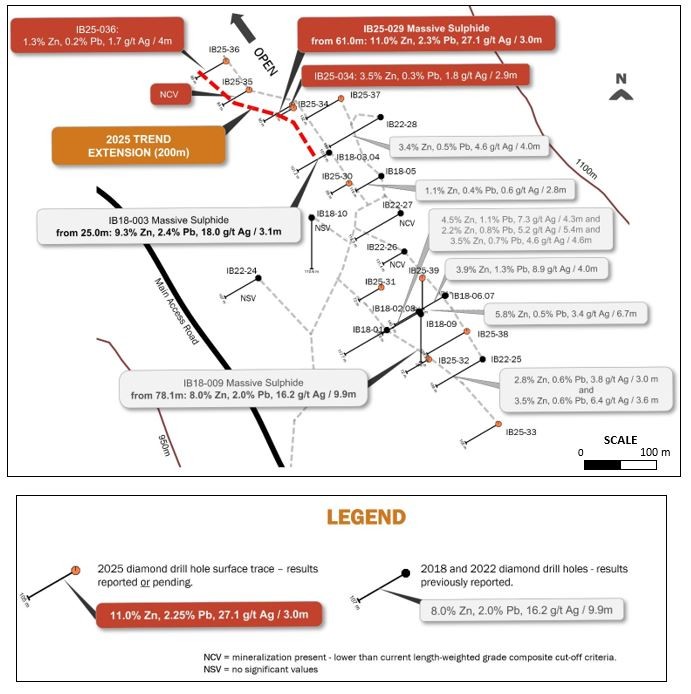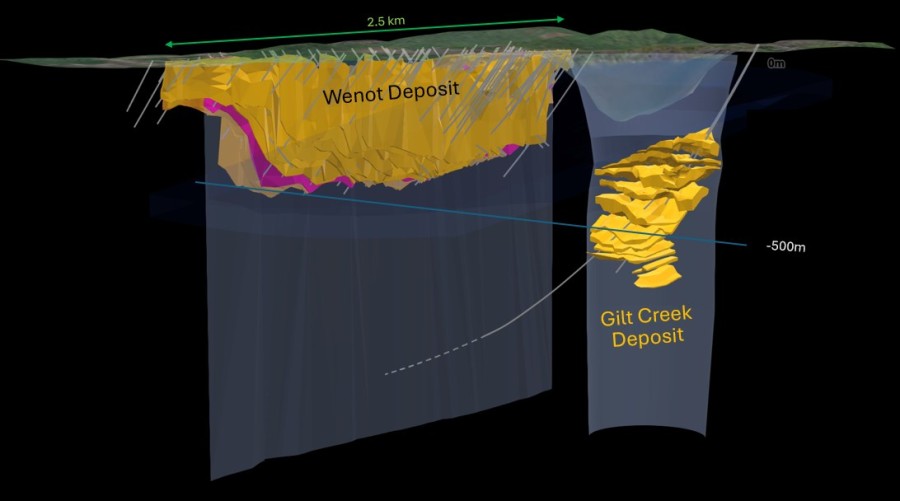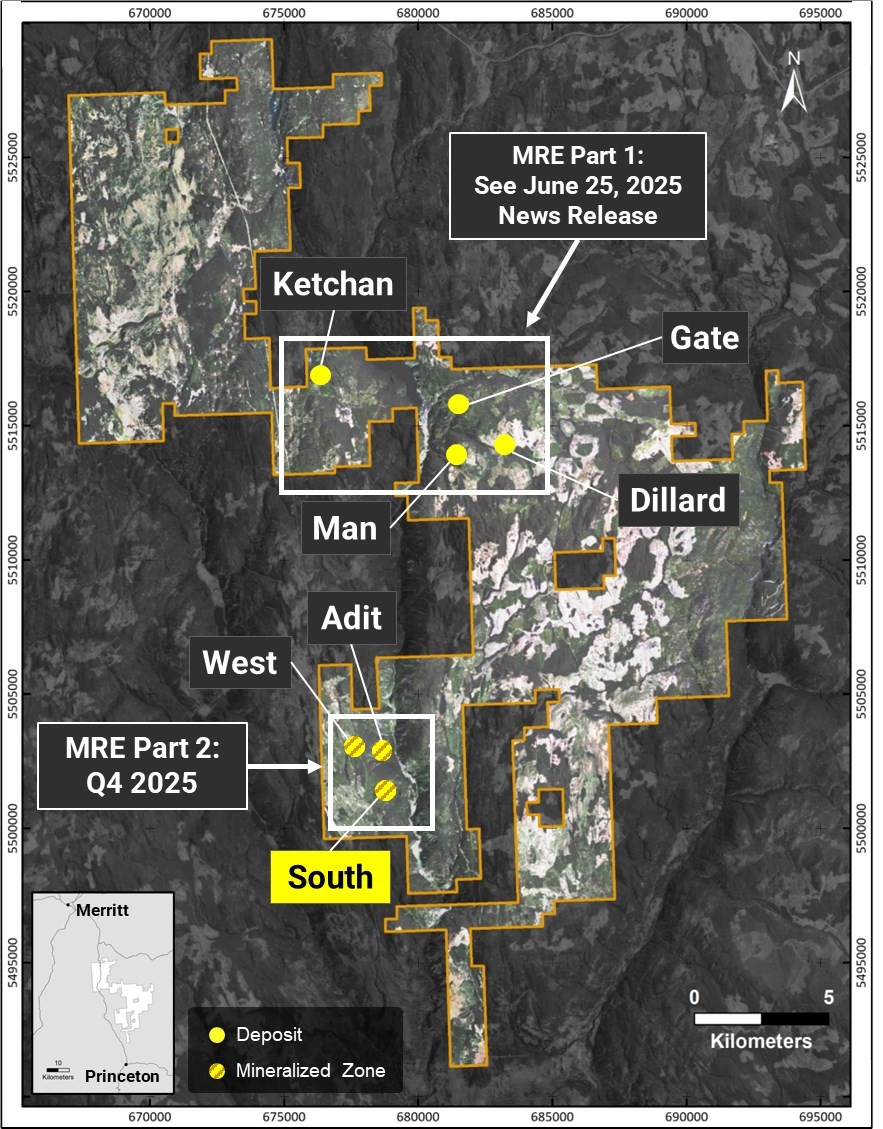Extended mineralization confirms 6 km strike at Lac Tétépisca – results strengthen the potential of one of North America’s most significant natural flake graphite deposits
May 28th, 2025 – TheNewswire - Ottawa, ON – Focus Graphite Advanced Materials Inc. (TSX.V: FMS | OTCQB: FCSMF | FSE: FKC) (“Focus” or the “Company”), is pleased to announce additional assay results from 13 drill holes completed as part of the 2022 exploration and definition drilling program at its 100%-owned Lac Tétépisca project (the “Project”). These drill holes targeted the southwestern extension of the Manicouagan-Ouest Graphitic Corridor (“MOGC”) flake graphite deposit, specifically the area where the MOCG converges with the West Limb. Drilling in this area has now extended the strike length of the mineralized zone to over 6 kilometres. Assay results from an additional 22 drill holes located in the West Limb of the deposit remain pending.
The MOGC flake graphite deposit is part of Focus Graphite’s Lac Tétépisca project, located southwest of the Manicouagan Reservoir in the Côte-Nord administrative region of Québec, on the Nitassinan of the Pessamit Innu First Nation. The MOGC is defined by a linear 1.5 km-long segment of an 8 km-long folded geophysical magnetic-electromagnetic anomaly trending N035°. The current maiden MRE, outlined in the NI 43-101 Technical Report Mineral Resource Estimate Lac Tétépisca Graphite Project, Québec dated April 4, 2022 (prepared by DRA Americas Inc. and available on SEDAR+ on the Company’s profile), includes:
-
Indicated Resource: 59.3 million tonnes (Mt) grading 10.61% Cg, for an estimated 6.3 Mt of in-situ natural flake graphite
-
Inferred Resource: 14.9 Mt grading 11.06% Cg, for an estimated 1.6 Mt of in-situ natural flake graphite
An updated MRE incorporating data from 74 drill holes completed in the 2022 program is expected by late summer 2025. This growing deposit continues to position the MOGC as one of the most potentially significant sources of natural flake graphite in North America.
Dean Hanisch, CEO of Focus Graphite, commented, “We are encouraged by the latest drill results, which confirm the continuity of graphitic mineralization across the entire length of the folded structure – effectively connecting both limbs of the mineralized system. Importantly, the deposit remains open at depth. While grades vary, the system is now confirmed over an impressive 6-kilometre strike length. Given that this system refolds within a compact 3-kilometre footprint, it presents the opportunity for a single, large-scale mining operation – potentially one of the largest in the Americas. Preliminary metallurgical testing has also confirmed the excellent quality of our flake graphite, which is now undergoing further evaluation for premium-grade battery applications by Charge C4V and AETC”.
2022 Exploration and Definition Drill Program
Focus Graphite completed 14,900.5 metres of core drilling at the Lac Tétépisca project between March 3 and November 17, 2022, for a total of 74 holes. The exploration and definition drilling program had two primary objectives:
-
To conduct systematic definition drilling along strike and at depth of the MOGC deposit, with the aim of upgrading Inferred mineral resources to the Indicated category and expanding total mineral resources.
-
To test the graphite abundance potentially responsible for the magnetic and aeromagnetic anomaly extending from the MOGC toward the Southwest extension and West Limb.
To date, the Company has received and released analytical results for twenty-seven (27) definition drill holes along strike of the MOGC deposit. Analytical results for the seventeen (17) exploration holes drilled at the Southwest MOGC target have also been received. Of these, twelve (12) were previously disclosed in previous news releases, while the remaining six (6) are reported in this release, along with results from the first seven (7) exploration holes drilled at the West Limb. Analytical results for the remaining twenty-two (22) exploration drill holes from West Limb are still pending.
This news release presents results from six (6) exploration holes drilled into the Southwest MOGC exploration target (Table 1, Figure 1) and seven (7) exploration holes drilled at the nearby West Limb target (Table 2, Figure 1).
For previous news releases summarizing analytical highlights from the 2022 exploration and definition drilling program at the Lac Tétépisca project – including associated maps – please visit the Company’s website at www.focusgraphite.com.
Southwest MOGC Exploration Drill Results
Drilling at the Southwest MOGC target consisted of eighteen (18) exploration holes totalling 2,838.8 metres. This release reports results from six (6) of those holes (Table 1), covering nearly one (1) kilometre of the anomaly’s strike length. One drill hole intersected significant graphitic mineralization:
Hole LT-22-170
-
Drilled at 360°/-45° to a vertical depth of 104.75 metres on Section L5+75SW, intersected 6.27 metres (true thickness) grading 5.52% Cg (from 14.00 to 21.00 metres core length).
To date, the graphitic zones intersected at the Southwest MOGC target are generally thinner or of lower grade than those in the MOGC deposit and occur at different stratigraphic levels. Detailed structural 3D modelling is currently underway to investigate the potential connection between the MOGC deposit and the Southwest MOGC target.
West Limb Exploration Drill Results
The West Limb zone consists of the other segment of the regionally folded aeromagnetic anomaly and appears to mirror the southern limb hosting the MOGC. The anomaly in the area is twinned, suggesting the presence of two (2) subparallel conductive horizons. Drilling at the West Limb target included 29 exploration holes, completed over a systematic grid and totalling 5,421.6 metres. This release reports results from the first seven (7) exploration holes (Table 2), all located on the southwest and least intense horizon of the anomaly. Of these, two (2) drill holes intersected significant graphitic mineralization:
Hole LT-22-110
-
Drilled at 350°/-45° to a vertical depth of 171.30 metres on Sections L15+00NW and L16+00NW, intersected 10.10 metres (true thickness) grading 5.46% Cg (from 33.00 to 49.00 metres core length).
Hole LT-22-112
-
Drilled at 300°/-45° to a vertical depth of 118.74 metres on Section L16+00NW,
-
Intersected 6.27 metres (true thickness) grading 5.52% Cg (from 14.00 to 21.00 metres core length).
-
Intersected 19.35 metres (true thickness) grading 9.68% Cg (from 73.00 to 93.00 metres core length). Including 8.71 metres (true thickness) grading 14.95% Cg (from 84.00 to 93.00 metres core length).
-
Although the results reported did not indicate mineralization to the same extent as the main zone of the MOGC, they demonstrate the continuity of broad, low grade graphitic mineralization along strike. These findings also highlight the structural complexities near the regional fold hinge, which may contribute to future resource expansion. As with previous releases, significant mineralization is defined as graphitic carbon (Cg) grading a minimum of 5.0% over at least 6.0 metres of true thickness, with a maximum of 7.0 of consecutive internal dilution and no external dilution. While several low-grade, broad intersections do not meet this threshold, they are considered important for the upcoming mineral resource estimate (“MRE”) update.
Figure 1: Location of the drill holes and drill hole sections discussed in today’s news release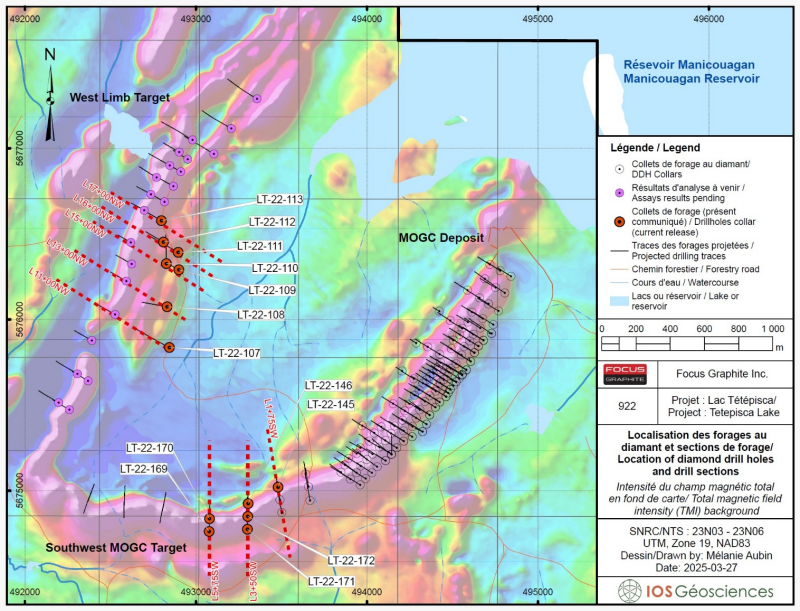
Table 1: Highlights from the six exploration holes drilled at the Southwest MOGC target in 2022 and released today
Table 2: Highlights from the seven (7) exploration holes drilled at the West limb MOGC target in 2022 released today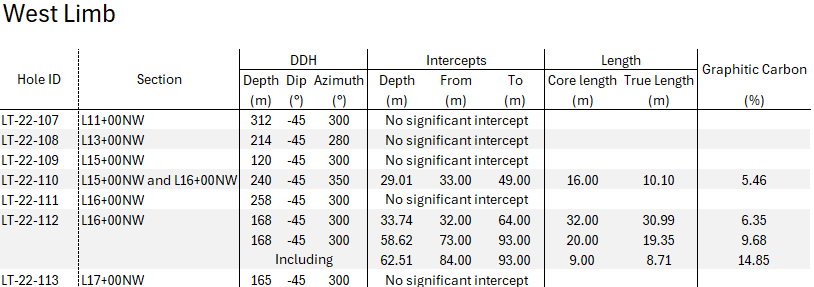
Notes:
(1) True thicknesses are reported in this news release and are based on the local dip of the mineralised envelope as calculated on 3-D model. Core descriptions, sampling information and analytical results were captured in Geotic™ core logging software and then used with LeapFrog Geo software for three-dimensional (3-D) rendering. The 3-D mineralisation envelope of MOCG has an azimuth of N035.5° and dips at -58.5° to the south-east. The drill holes crosscut the envelope of the main mineralised zone’s strike (80°) and dips (60o) at high angle.
(2) “Best intercepts” and “significant graphitic mineralisation” are defined as Cg grading a minimum of 5.0% over at least 6.0 m with internal dilution set at a maximum of 7.0 m consecutive and no external dilution. “Best sub-intercepts” are defined as Cg grading a minimum of 10.0% over 6.0 m with same limitations on dilution. The 5% cg and 10% Cg cut-offs are used solely to delineate the extent of the mineralised envelopes corresponding to “Best intercepts” and “Best sub-intercepts”, respectively. Economic cut-offs based on geological, metallurgical, mining, and economic factors, parameters and considerations will be determined as part of the mineral resource estimate update planned for the Lac Tétépisca project later through subsequent technical studies.
(3) Barren core intervals within the mineralised envelope of the MOGC that were not analysed are considered as 0.0% Cg internal dilution.
(4) Analyses were performed by Activation Laboratories of Ancaster, Ont., an ISO/IEC 17025:2005 certified facility using combustion in induction furnace and infrared spectrometry (code 4F – C-Graphitic) and are reported as graphitic carbon (Cg) and total sulphur (code 4F-S), with about 10% of the sample duplicated for quality control analyzed by COREM. Except for holes 145 and 146, where all the samples were analysed by COREM and the cross checks by ACTLABS for quality control.
(5) QA/QC program: IOS introduced 17% reference samples, including certified and internal reference materials, duplicates, and blank samples. 9.7 percent of the drill core samples were duplicated and analyzed by COREM for graphitic, total, organic and inorganic carbon as well as total sulphur (or by ACTLABS for duplicated samples in holes 145 and 146). The same 9.7 % of the drill core samples were also analysed by ACTLABS Laboratories of Ancaster, Ontario (ISO/IEC 17025:2005 with CAN-P-1579) for trace metals by ICP-MS after aqua-regia digestion (code 1E2).
(5) Although holes LT-22-149, LT-22-150, LT-22-151 and LT-22-153 are present on the graphical sections, their respective assay results are still pending.
2022 drill program: design, operation, and quality control
The 2022 drilling program was designed and operated by IOS Géosciences Inc. (IOS) of Saguenay, Québec, under the supervision of Table Jamésienne de Concertation Minière (TJCM) of Chibougamau, Québec, acting as technical adviser to the Company. Drilling was performed by Forage G4 of Val-d’Or, Québec using a single drill rig.
Sample preparation and analysis
Starting in March 2022, drill core boxes for each hole were packaged by sequential numbers onto pallets in the field by IOS personnel and then shipped by truck every two weeks to IOS’s facilities in Saguenay where they are currently archived. Sampling has been conducted with a diamond saw, with NQ-diameter core from the Southwest MOGC and West Limb targets being halved, while all HQ-diameter core from the MOGC deposit was quartered. Sample preparation work at IOS consisting of crushing and grinding and the insertion in the sample sequences of QA/QC samples. A total of 545 pulverized splits from the currently disclosed set of drill holes were sent to Activation Laboratories in Ancaster, Ontario (ISO/IEC 17025:2005 with CAN-P-1579) for graphitic carbon (code 4F – C-Graphitic) and total sulphur analysis (code 4F – S) using an Eltra® induction furnace with infrared spectroscopy. However, holes 145 and 146 followed the process prior to the inversion of the laboratories (Corem as first laboratory and verification by actlabs). The 14 samples from holes 145 and 146 were analysed by COREM for graphitic carbon (code B10) and total sulphur (code B41). The subset of 9.7% of samples was also analyzed for 40 trace element analysis using ICP-OES and ICP-MS after an aqua-regia digestion at Activation Laboratories (Code 1E2 – Aqua Regia). This brings the total number of core samples analyzed under the project to more than 9,800, excluding reference materials and duplicates.
Quality Assurance / Quality Control
The analytical quality control program for the Lac Tétépisca project has been implemented by an IOS-certified chemist and is identical to the one used for previous drill programs at Lac Tétépisca and at the Company’s Lac Knife project. Under the QA/QC program, a total of 54 duplicates of the core samples, or 9.7 %, were analysed by the two selected laboratories. The current set of analyses included 52 duplicates of the core samples which were analyzed by COREM for graphitic carbon duplicated analyses (code B10), total sulphur (code B41), total carbon (code B45), organic carbon (code B58) and inorganic carbon (code B11) and the 2 duplicates of the core samples from holes 145 and 146 were analyzed by Activation Laboratories for graphitic carbon (code 4F – C-Graphitic) and total sulphur analysis (code 4F – S), in accordance with the QAQC plan when these holes are treated. A total of 105 reference materials (about 17% of all the samples analysed) were inserted in the sample sequences, either certified or internal reference material samples (CDN-GR1, CMRI12, Oreas-723, OREAS-724, OREAS-725, CGL-004, NCS-DC-60119), duplicates (quarter-split core or grinding duplicates), and preparation and analyses blanks.
Qualified Persons
The technical content disclosed in this news release was reviewed and approved by Réjean Girard, P.Geo. (QC), President of IOS Geosciences Inc., a consultant to the Company, and a qualified person as defined under National Instrument NI-43-101.
About the Lac Tétépisca Graphite Project
Focus Graphite’s 100%-owned Lac Tétépisca Graphite Project is in the Southwest Manicouagan reservoir area of the Côte-Nord region of Québec, one of North America’s leading emerging flake graphite districts. The project lies on the Nitassinan of the Pessamit Innu First Nation, 234 km north-northwest of the city of Baie-Comeau, an industrial city located where the Manicouagan River intersects the north shore of the St. Lawrence River. It comprises two contiguous properties, Lac Tétépisca and Lac Tétépisca Nord. Together, the two properties form a block of 126 map-designated claims (total area: 6,785.14 ha). Focus purchased a 100% unencumbered interest of the mineral rights in the 67 CDC claims constituting the original Lac Tétépisca property from a third party in August 2011. The Lac Tétépisca Nord property was map-staked by the Company in 2012. The Lac Tétépisca Project is accessible year-round by way of a network of secondary gravel roads that extend north from Highway 389, 10 km to the south of the Manic 5 hydroelectric power station.
From 2014 to 2021, Focus tested the Manicouagan-Ouest Graphitic Corridor with 106 drill holes drilled over a 1.4 km strike length (total: 16,468 metres). The drilling formed the basis of a NI 43-101 maiden mineral resource estimate (MRE) for the Lac Tétépisca graphite project with the MRE technical report filed on SEDAR+ on April 5, 2022. The mineral resource estimate, prepared by DRA Global Limited’s Montréal office, includes a pit-constrained Indicated resource for the MOGC prospect at the Lac Tétépisca project of 59.3 million tonnes (Mt) grading 10.61% Graphitic Carbon (Cg) for an estimated content of 6.3 Mt of natural flake graphite (in-situ), and an Inferred resource of 14.9 Mt grading 11.06% Cg for an estimated content of 1.6 Mt of natural flake graphite.
Additional maps of the Lac Tétépisca property showing the location of the MOGC graphite deposit, along with updated drill sections, are available on the Company’s website at www.focusgraphite.com.
About Focus Graphite Advanced Materials Inc.
Focus Graphite Advanced Materials is redefining the future of critical minerals with two 100% owned world-class graphite projects and cutting-edge battery technology. Our flagship Lac Knife project stands as one of the most advanced high-purity graphite deposits in North America, with a fully completed feasibility study. Lac Knife is set to become a key supplier for the battery, defense, and advanced materials industries.
Our Lac Tétépisca project further strengthens our portfolio, with the potential to be one of the largest and highest-purity and grade graphite deposits in North America. At Focus, we go beyond mining – we are pioneering environmentally sustainable processing solutions and innovative battery technologies, including our patent-pending silicon-enhanced spheroidized graphite, designed to enhance battery performance and efficiency.
Our commitment to innovation ensures a chemical-free, eco-friendly supply chain from mine to market. Collaboration is at the core of our vision. We actively partner with industry leaders, research institutions, and government agencies to accelerate the commercialization of next-generation graphite materials. As a North American company, we are dedicated to securing a resilient, locally sourced supply of critical minerals – reducing dependence on foreign-controlled markets and driving the transition to a sustainable future.
For more information on Focus Graphite Inc. please visit http://www.focusgraphite.com
Investors Contact:
Dean Hanisch
CEO, Focus Graphite Inc.
This email address is being protected from spambots. You need JavaScript enabled to view it.
+1 (613) 612-6060
Jason Latkowcer
VP Corporate Development
This email address is being protected from spambots. You need JavaScript enabled to view it.
Cautionary Note Regarding Forward-Looking Statements
Certain statements contained in this press release constitute forward-looking information. These statements relate to future events or future performance. The use of any of the words “could,” “intend,” “expect,” “believe,” “will,” “projected,” “estimated,” and similar expressions, as well as statements relating to matters that are not historical facts, are intended to identify forward-looking information and are based on the Company’s current beliefs or assumptions as to the outcome and timing of such future events.
In particular, this press release contains forward-looking information relating to, among other things the timing and outcome of the updated Mineral Resources Estimate (“MRE”) flake graphite deposit, the geological continuity and potential expansion of the MOGC flake graphite deposit, the interpretation of recent drilling results and their implications for resource growth and mine development, the future metallurgical performance of graphite flakes and their suitability for premium battery-grade applications, the potential for establishing a large-scale mining operation accessible from a single site footprint, and the Company’s position as a secure, North American supplier of high-quality flake graphite for critical applications in batteries, semiconductors, and defense sectors. It also includes statements regarding the potential geopolitical significance of Canadian graphite supply, the Company's positioning as a near- and long-term secure supplier of specialty graphite materials, and the anticipated revised mineral resource estimate of the Tétépisca project.
Forward-looking statements are subject to known and unknown risks, uncertainties, and other factors that may cause actual results, performance, or achievements to differ materially from those expressed or implied by such statements. These risks and uncertainties include, but are not limited to, risks related to market conditions, regulatory and permitting risks, changes in economic conditions, risks related to project development and technical feasibility, risks related to metallurgical performance and commercial viability, the ability to raise sufficient funds on acceptable terms or at all, operational risks associated with mineral exploration and development, and other risks detailed from time to time in the Company’s public disclosure documents available under its profile on SEDAR+.
The forward-looking information contained in this release is made as of the date hereof, and the Company is not obligated to update or revise any forward-looking information, whether as a result of new information, future events, or otherwise, except as required by applicable securities laws. Because of the risks, uncertainties, and assumptions contained herein, investors should not place undue reliance on forward-looking information.
Neither TSX Venture Exchange nor its Regulation Services accepts responsibility for the adequacy or accuracy of this release.


